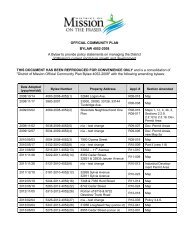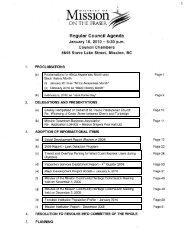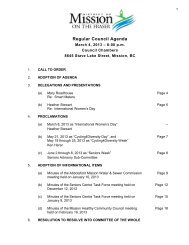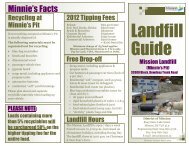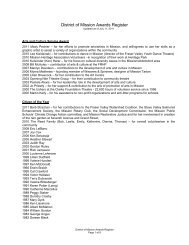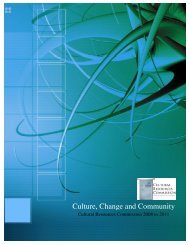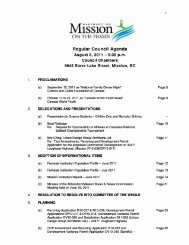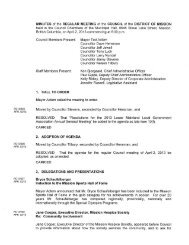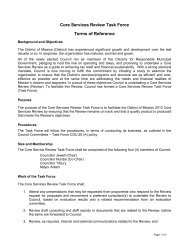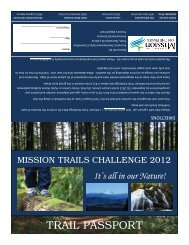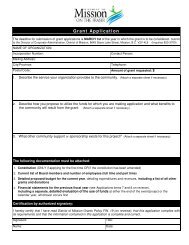July 6, 2009 - District of Mission
July 6, 2009 - District of Mission
July 6, 2009 - District of Mission
- No tags were found...
You also want an ePaper? Increase the reach of your titles
YUMPU automatically turns print PDFs into web optimized ePapers that Google loves.
50Many seismic design methods, including the analysis <strong>of</strong> the stability <strong>of</strong> slopes during andshortly after an earthquake (seismic slope analysis4 ), are based on ground motions. Insome areas <strong>of</strong> British Columbia, the above change in design ground motions resulted inan approximate doubling <strong>of</strong> the peak around acceleration (PGA) used in seismic slopeanalysis.Using current practice, the effect <strong>of</strong> this change was to increase the number <strong>of</strong> slopesthat could be considered unstable during an earthquake, and therefore potentially notsuitable for residential .deveiopment. This caused concern to Land Owners,Development Consultants, losal governments, and the provincial government (Kuan20071As a temporary measure, the provincial government, by special regulation 'LocalGovernment Act, Section ,692(d), Provincial Regulation M268, Geotechnical SlopeStability - (Seismic) Regulation (December 20067, permitted the use <strong>of</strong> the NBCC 199Eand BCBC 1998 ground motions (ID% in 50-year pound motions) for seismic slopea.naiysis. As a result, APEGBC, with support from the provincial government,established a Task Force on Seismic Slope Stability (TFSSS) to study this issue and tomake appropriate recommendations.The TFSSS reviewed current practice and recent developments in seismic slopeanaysis These 20D revised Guidelines introduce two new methods <strong>of</strong> seismic slope,analysis <strong>of</strong> soil slopes based on the concept <strong>of</strong> tolerable earthquake-induced slopedisplacements alma a slip surface_ The 2008 revisions include the addition <strong>of</strong> a newChapter 4 and four Appendices (Appendix E, Appendix F, Appendix G and Appendix H)..Other minor revisions have also been made.1.1 PURPOSE OF THE GUIDELINESThis document (1) provides guidelines <strong>of</strong> pr<strong>of</strong>essional practice for a Pr<strong>of</strong>essionalEngineer and Pr<strong>of</strong>essionai Geossientist wnc carries out a landslide analysis for aproposed residential development, and (2) provides guidance to the pr<strong>of</strong>essional as tohow to relate the results <strong>of</strong> the analysis to a level <strong>of</strong> landslide safety for residentialdeve.looinent when required by provincial legislation. Appendix D to these Guidelinesprovides a Landslide Assessment Assurance Statement that must be submitted, alongwith a is stilde assessment report, to an Approving Authority.Land Owners and Devei-apment Consultants: Land Use Planners, Approving Officers .and Building inspectors: kriunicipalities Reg.'onal <strong>District</strong>s, and the islands True; theprovincial gdemment; and the general public frequently rely on such iandsiideassessments. These Guidelines may also assist those parties.These Guidelines address typical project organLzation and respcns:blhies <strong>of</strong> the venousstakeholders; pr<strong>of</strong>essional practices that should typically be provided: qualityassuranceiquaiit-y control, and pr<strong>of</strong>essions registration and education, training andexperience.Seismis slope analysis ine-tudes both, seismic slope sability analysis and seismic slope dispiacementanalysis.Municipalities. Regi'onal <strong>District</strong>- and the islands Trust are coitectively referred to as lose coveminents.APEGEC *March 213:26.7:e0 se September 23E18Cjiiidetne,s Ledsisted Lanciai:ds <strong>of</strong>t sseavnent.io, Precasev Fez fiarekkopment Eritisi) Cation:WEPAGE 20 OF 73



